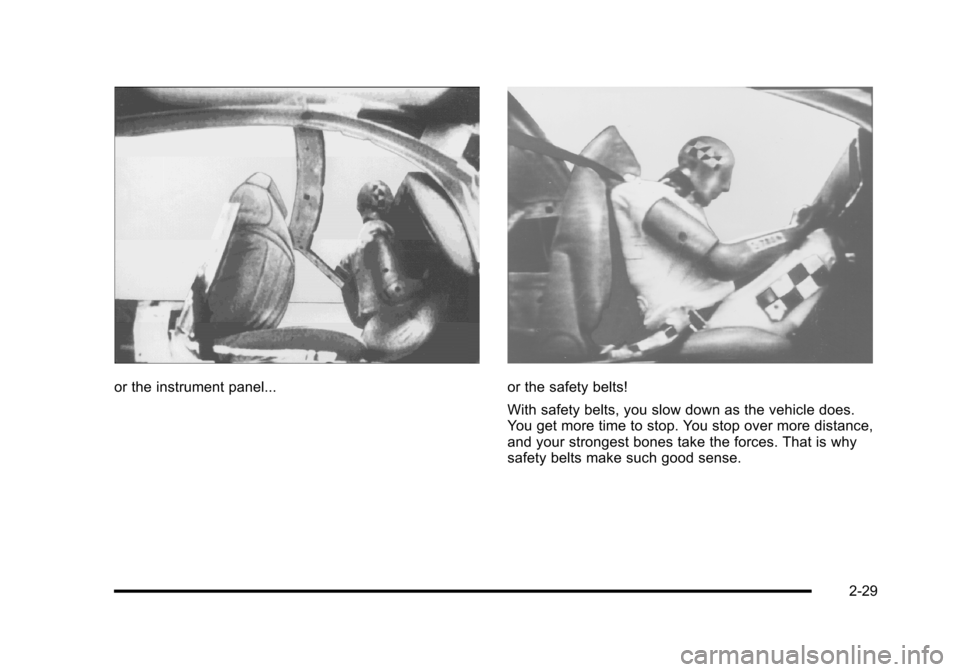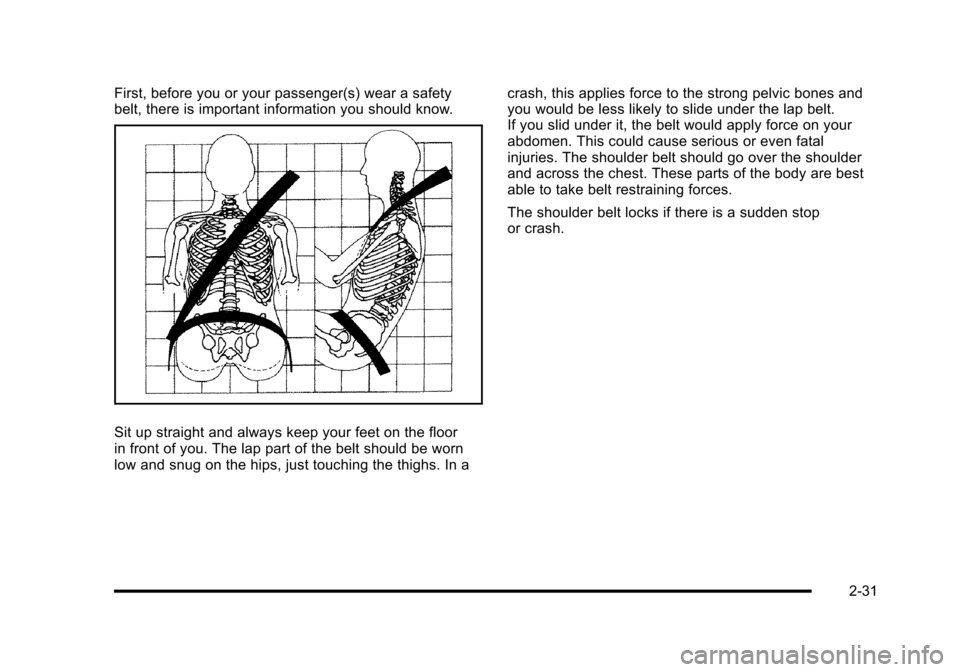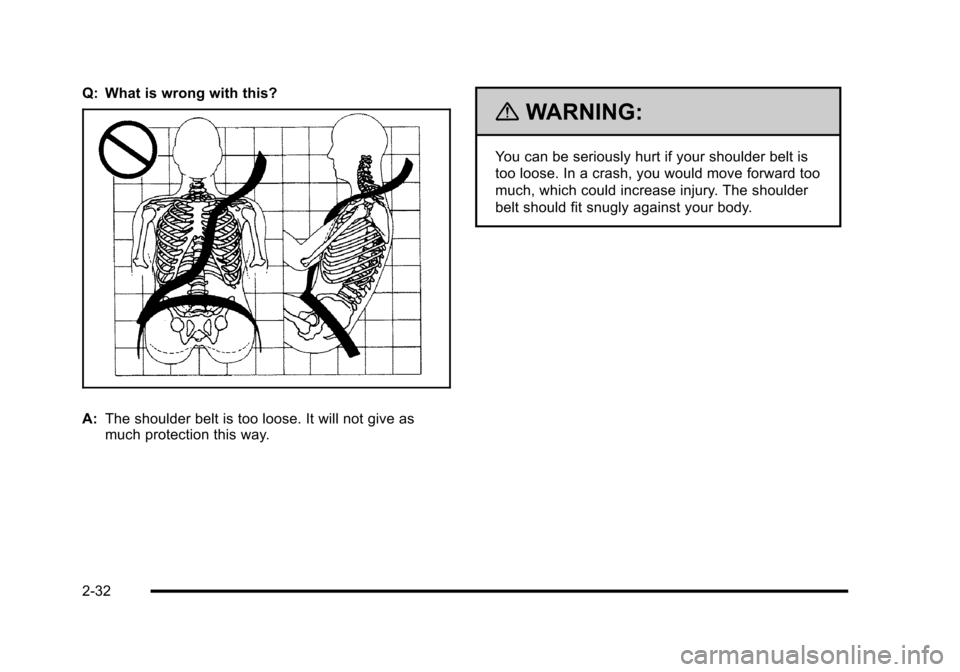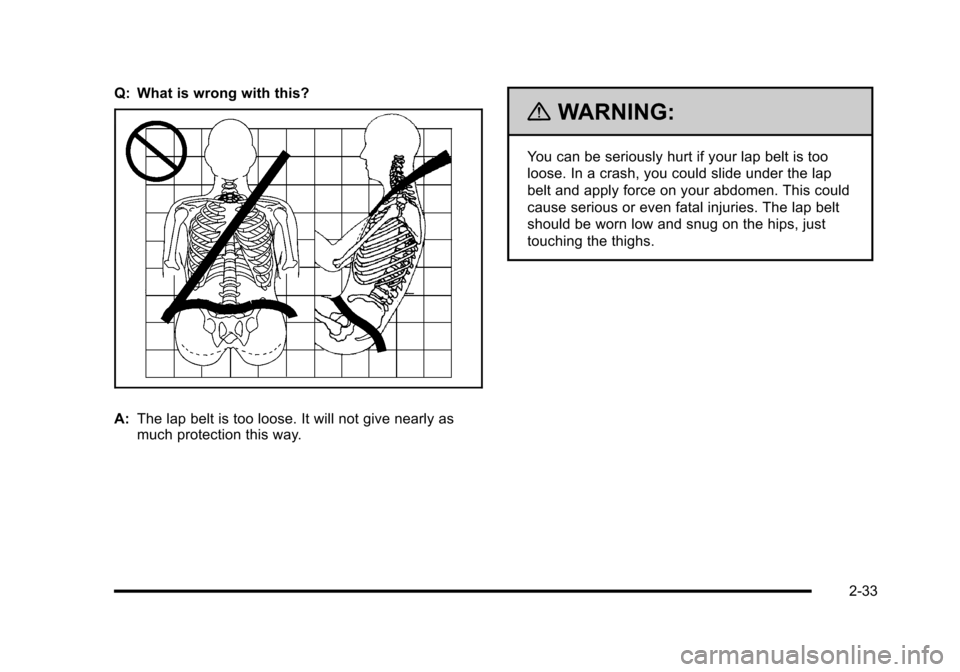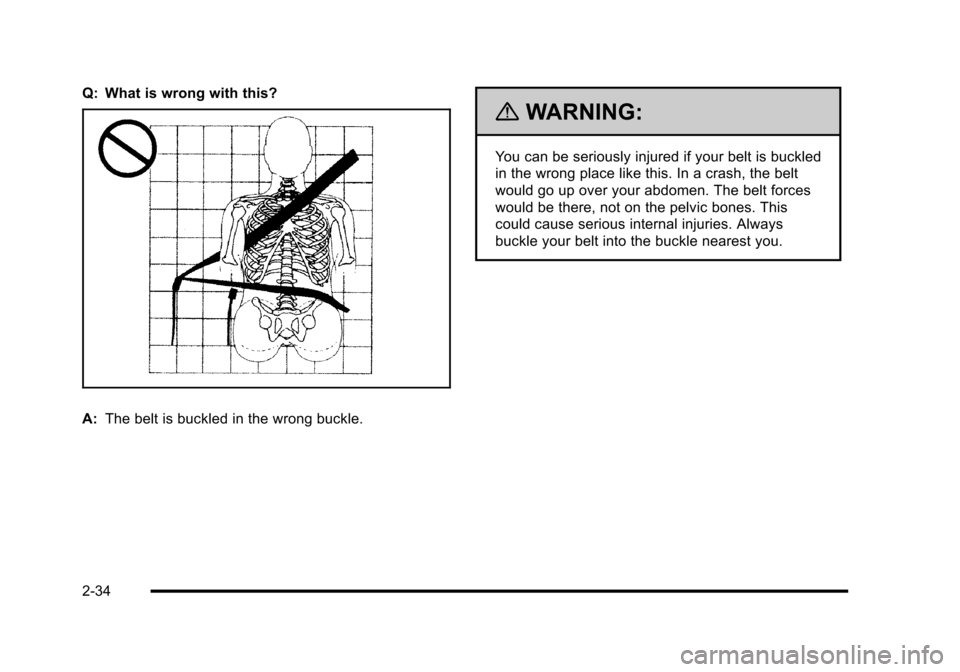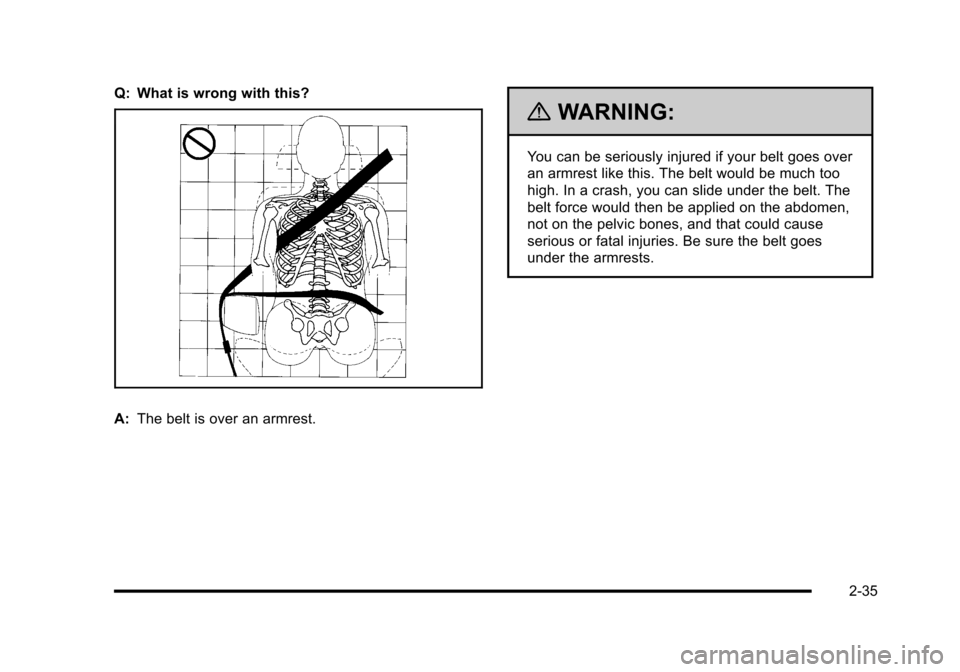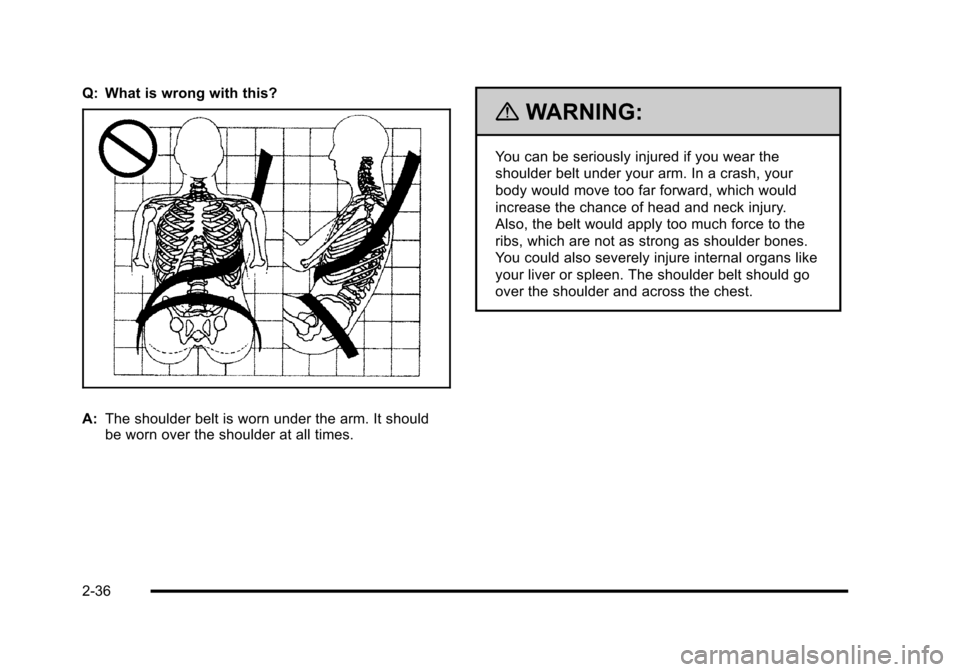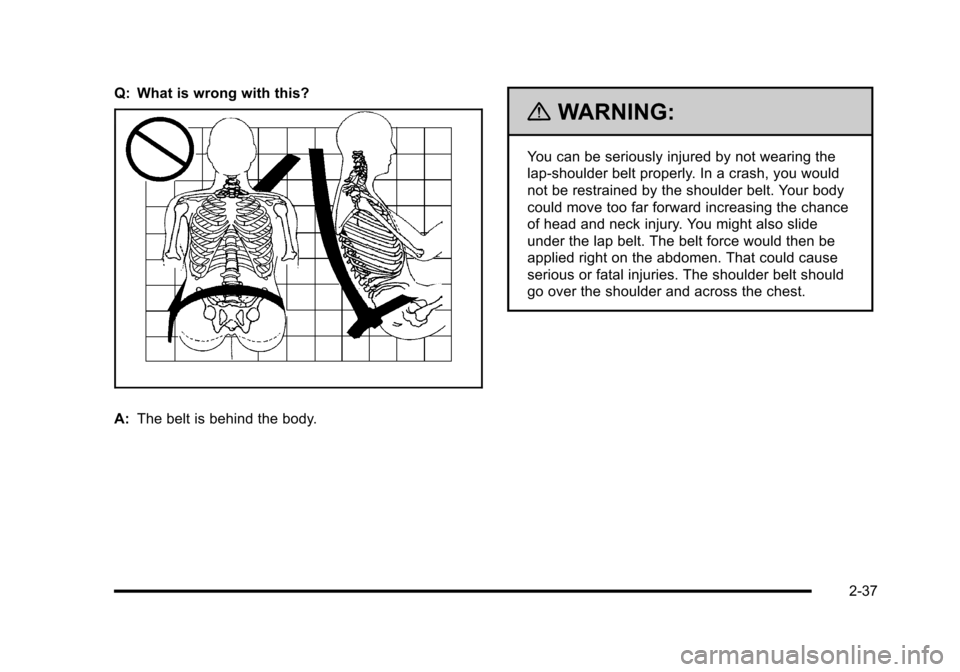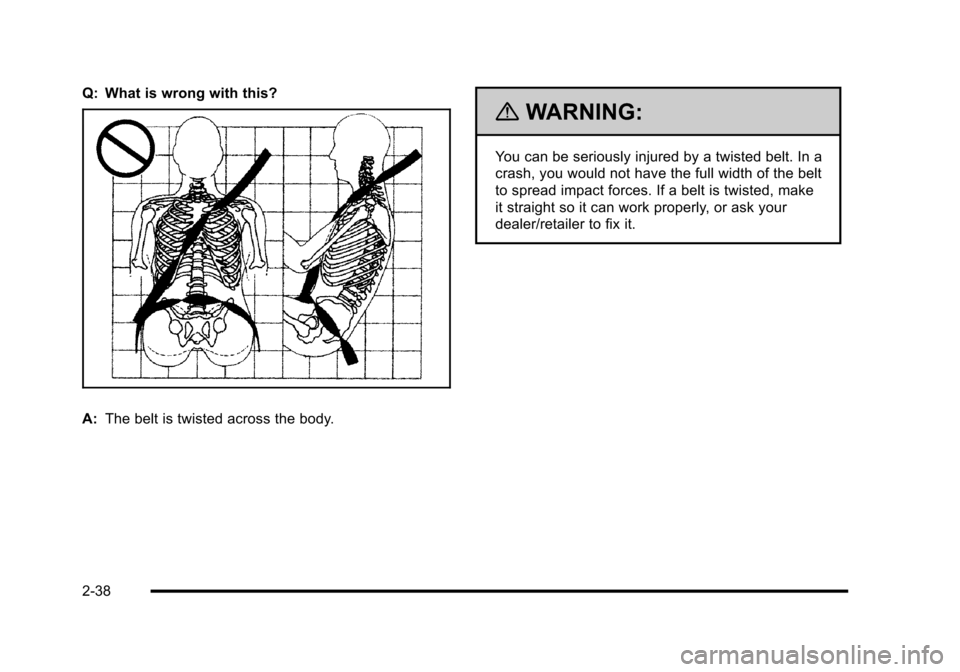CADILLAC ESCALADE 2010 3.G Repair Manual
ESCALADE 2010 3.G
CADILLAC
CADILLAC
https://www.carmanualsonline.info/img/23/7913/w960_7913-0.png
CADILLAC ESCALADE 2010 3.G Repair Manual
Trending: park assist, sunroof, compression ratio, ESP, diagram, parking brake, climate control
Page 61 of 616
or the instrument panel...or the safety belts!
With safety belts, you slow down as the vehicle does.You get more time to stop. You stop over more distance,and your strongest bones take the forces. That is whysafety belts make such good sense.
2-29
Page 62 of 616
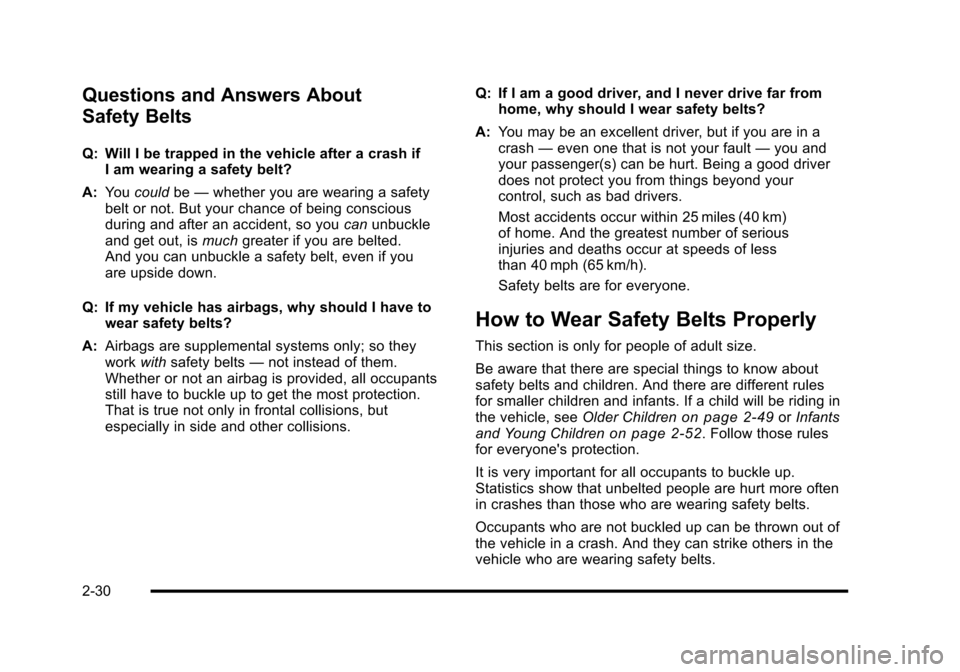
Questions and Answers About
Safety Belts
Q: Will I be trapped in the vehicle after a crash ifI am wearing a safety belt?
A:Youcouldbe—whether you are wearing a safetybelt or not. But your chance of being consciousduring and after an accident, so youcanunbuckleand get out, ismuchgreater if you are belted.And you can unbuckle a safety belt, even if youare upside down.
Q: If my vehicle has airbags, why should I have towear safety belts?
A:Airbags are supplemental systems only; so theyworkwithsafety belts—not instead of them.Whether or not an airbag is provided, all occupantsstill have to buckle up to get the most protection.That is true not only in frontal collisions, butespecially in side and other collisions.
Q: If I am a good driver, and I never drive far fromhome, why should I wear safety belts?
A:You may be an excellent driver, but if you are in acrash—even one that is not your fault—you andyour passenger(s) can be hurt. Being a good driverdoes not protect you from things beyond yourcontrol, such as bad drivers.
Most accidents occur within 25 miles (40 km)of home. And the greatest number of seriousinjuries and deaths occur at speeds of lessthan 40 mph (65 km/h).
Safety belts are for everyone.
How to Wear Safety Belts Properly
This section is only for people of adult size.
Be aware that there are special things to know aboutsafety belts and children. And there are different rulesfor smaller children and infants. If a child will be riding inthe vehicle, seeOlder Childrenon page 2!49orInfantsand Young Childrenon page 2!52. Follow those rulesfor everyone's protection.
It is very important for all occupants to buckle up.Statistics show that unbelted people are hurt more oftenin crashes than those who are wearing safety belts.
Occupants who are not buckled up can be thrown out ofthe vehicle in a crash. And they can strike others in thevehicle who are wearing safety belts.
2-30
Page 63 of 616
First, before you or your passenger(s) wear a safetybelt, there is important information you should know.
Sit up straight and always keep your feet on the floorin front of you. The lap part of the belt should be wornlow and snug on the hips, just touching the thighs. In a
crash, this applies force to the strong pelvic bones andyou would be less likely to slide under the lap belt.If you slid under it, the belt would apply force on yourabdomen. This could cause serious or even fatalinjuries. The shoulder belt should go over the shoulderand across the chest. These parts of the body are bestable to take belt restraining forces.
The shoulder belt locks if there is a sudden stopor crash.
2-31
Page 64 of 616
Q: What is wrong with this?
A:The shoulder belt is too loose. It will not give asmuch protection this way.
{WARNING:
You can be seriously hurt if your shoulder belt is
too loose. In a crash, you would move forward too
much, which could increase injury. The shoulder
belt should fit snugly against your body.
2-32
Page 65 of 616
Q: What is wrong with this?
A:The lap belt is too loose. It will not give nearly asmuch protection this way.
{WARNING:
You can be seriously hurt if your lap belt is too
loose. In a crash, you could slide under the lap
belt and apply force on your abdomen. This could
cause serious or even fatal injuries. The lap belt
should be worn low and snug on the hips, just
touching the thighs.
2-33
Page 66 of 616
Q: What is wrong with this?
A:The belt is buckled in the wrong buckle.
{WARNING:
You can be seriously injured if your belt is buckled
in the wrong place like this. In a crash, the belt
would go up over your abdomen. The belt forces
would be there, not on the pelvic bones. This
could cause serious internal injuries. Always
buckle your belt into the buckle nearest you.
2-34
Page 67 of 616
Q: What is wrong with this?
A:The belt is over an armrest.
{WARNING:
You can be seriously injured if your belt goes over
an armrest like this. The belt would be much too
high. In a crash, you can slide under the belt. The
belt force would then be applied on the abdomen,
not on the pelvic bones, and that could cause
serious or fatal injuries. Be sure the belt goes
under the armrests.
2-35
Page 68 of 616
Q: What is wrong with this?
A:The shoulder belt is worn under the arm. It shouldbe worn over the shoulder at all times.
{WARNING:
You can be seriously injured if you wear the
shoulder belt under your arm. In a crash, your
body would move too far forward, which would
increase the chance of head and neck injury.
Also, the belt would apply too much force to the
ribs, which are not as strong as shoulder bones.
You could also severely injure internal organs like
your liver or spleen. The shoulder belt should go
over the shoulder and across the chest.
2-36
Page 69 of 616
Q: What is wrong with this?
A:The belt is behind the body.
{WARNING:
You can be seriously injured by not wearing the
lap-shoulder belt properly. In a crash, you would
not be restrained by the shoulder belt. Your body
could move too far forward increasing the chance
of head and neck injury. You might also slide
under the lap belt. The belt force would then be
applied right on the abdomen. That could cause
serious or fatal injuries. The shoulder belt should
go over the shoulder and across the chest.
2-37
Page 70 of 616
Q: What is wrong with this?
A:The belt is twisted across the body.
{WARNING:
You can be seriously injured by a twisted belt. In a
crash, you would not have the full width of the belt
to spread impact forces. If a belt is twisted, make
it straight so it can work properly, or ask your
dealer/retailer to fix it.
2-38
Trending: trailer, light, oil pressure, park assist, width, wheel, cooling
